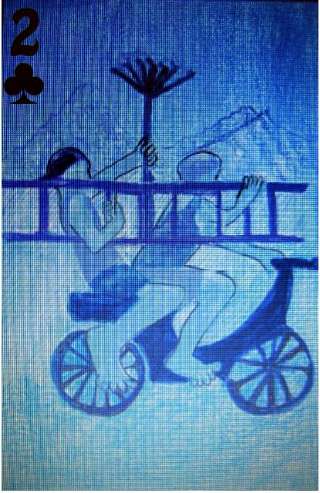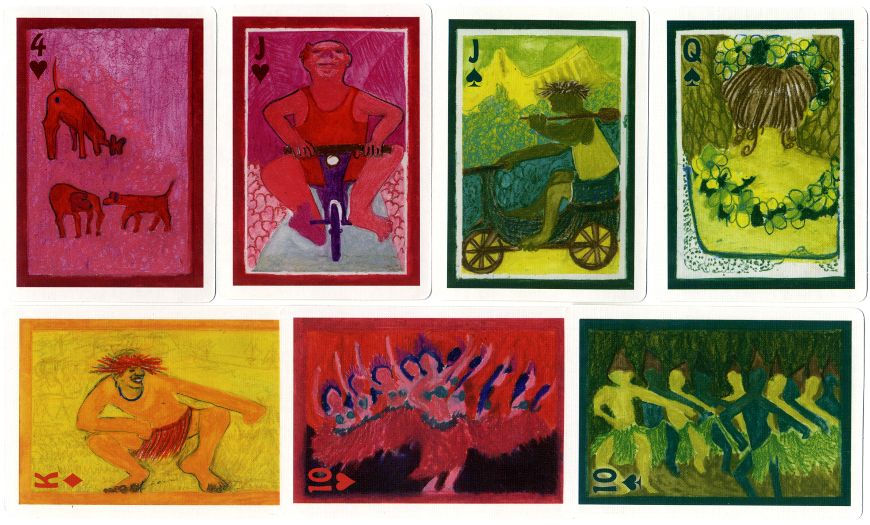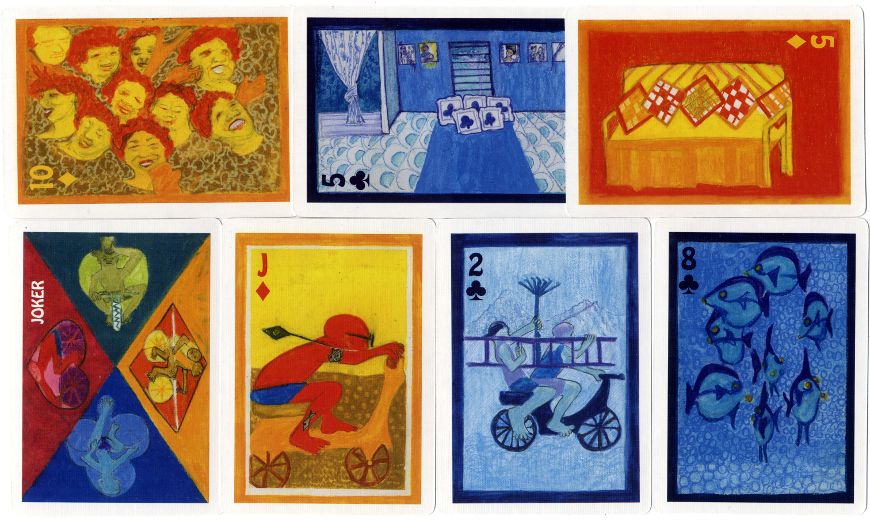The Big Deal
In ‘Patia Te Pere - The Big Deal’, Joan Gragg presents a first edition series of 1000 decks in which the characters, themes and patterns from traditional playing cards are replaced by Cook Islands cultural, environmental and societal icons.
Patia Te Pere - The Big Deal
Depicting daily life within a contemporary pacific society...

Above: original artwork for Two of Clubs, Caran D'ache water-soluble wax pastels.
For 32 years, Cook Island artist Joan Gragg has painted daily life in the Cook Islands.
In ‘Patia Te Pere - The Big Deal’, Joan re-presents her narrative within a first edition series of 1000 decks of playing cards in which the characters, themes and patterns from traditional playing cards are replaced by Cook Islands cultural, environmental and societal images.

The cards depict the unique social attributes on daily display within a contemporary3pacific society.
Right: back design, depicting an appliqué and embroidered bed cover.
While it is obvious to reference the popular local card game of Uka, a flamboyant, effusive performance more often supplemented by raucous laughter, drinks, ei katu and cigarettes, Joan's choice of artistic delivery (the cards) offers a poignant comment on the transposable and economic nature of culture itself.
With the Cook Islands Tourism increasingly recognising the commodity value of culture within its international marketing, Joan has created an affordable tourist souvenir for re-export and constant destination advertising wherever the cards may travel.
A discourse on the Sino-Pacific relationship and how it can fuel pacific tourism awareness and preserve local identity ensues. Also brought into question is the debate on culturally specific products, their manufacture, supplication and inherent market perception. (Notes by Ben Bergman. BCA gallery Rarotonga.)
Packs are available directly from Joan Gragg at $NZ 45.00/deck plus postage.
“The inspiration for the cards came from a deck of cards given to me ten years ago called “The Deck of Cards” by Andrew Jones Art. Cards drawn by 56 British artists. Our family enjoyed them because they were challenging and really made you think as to what each card was but also made them difficult to use as playing cards.”
“Card playing in the Islands is very popular. In 2010 I decided to paint a deck of cards about the Cook Islands. I used elements from my previous work which focuses on recording impressions and every day humorous events that are taken for granted in the Islands.”


Above: cards from Joan Gragg's "Playing Cards of the Pacific" Cook Islands Souvenir playing cards, 52 cards + Joker + extra card in hard box. Effusing vibrant energy in the colours and images, and an attractive way of presenting cards, giving a feel of the culture of the Islands.
“My deck of fifty four original paintings addresses some of the issues that made “The Deck of Cards” difficult to use when playing card games and especially Cook Islands euchre which is fast and rowdy. I have tried to incorporate into my deck elements like surprise, the twist on a subject, amusement, originality, intrigue, and fun. The four suits gave me a chance to paint four pictures of the same subject while the thirteen cards in each suit gave me the opportunity to also paint thirteen different subjects. Plus the joker.”
“The medium of water soluble crayons that I had bought in Auckland and loved because of their bright colour fitted my purposes perfectly. I worked in small format; 6 x 8.5 inches and restricted the colour for each suit using red for hearts, yellow orange for diamonds, blue for clubs and green for spades, further challenging my imagination and making it easy to identify the suits. I did at one time think it would be fun to not put any notation on the cards but card players insist on large lettering. I must admit we need the notation for euchre.” The cards are printed in China.

By Simon Wintle
Member since February 01, 1996
I am the founder of The World of Playing Cards (est. 1996), a website dedicated to the history, artistry and cultural significance of playing cards and tarot. Over the years I have researched various areas of the subject, acquired and traded collections and contributed as a committee member of the IPCS and graphics editor of The Playing-Card journal. Having lived in Chile, England, Wales, and now Spain, these experiences have shaped my work and passion for playing cards. Amongst my achievements is producing a limited-edition replica of a 17th-century English pack using woodblocks and stencils—a labour of love. Today, the World of Playing Cards is a global collaborative project, with my son Adam serving as the technical driving force behind its development. His innovative efforts have helped shape the site into the thriving hub it is today. You are warmly invited to become a contributor and share your enthusiasm.
Related Articles

National Gallery of Art
Fifty-three masterpieces from the collections of the National Gallery of Art, Washington.

Burghausen
Historical figures and buildings to promote the town of Burghausen, with designs by Jonny Petri.

Sannois dans les étoiles
Celebrities and buildings associated with Sannois, a commune in the suburbs of Paris.

Visite Mexico
Promoting Mexican tourism with 54 different photographs in full colour.

Baraja de Juan Martín Zamorano
Deck inspired by El Pendón de los Zamorano, a military pennant dating from 1501, published by Priego...

Treasures from the Bodleian Library
Rare books, manuscripts, music scores, portraits, maps, gospels, chronicles and other valuable artef...

Carte di Natale
Designed by Pier Canosa as a Christmas pack for the Cortina Art Gallery in Milan.

Queen of Arts
A wide variety of women artists celebrated on cards with illustrations by Laura Callaghan.

The Glasgow Pack
Issued to celebrate Glasgow’s reign as European City of Culture in 1990, with city views and works o...

Baraja Turística del País Vasco
Basque poker deck of 55 cards published by Fournier with scenic views of the Basque Country.

English Heritage
52 different colour photos of historic sites managed by English Heritage.

Art pack I
Art pack featuring Old Masters, including Bruegel, Vermeer, Titian, Raphael, Caravaggio, Canaletto, ...

Covered bridges playing cards
Historical covered bridges with photography by Bill Miller, 2006.

Hispania Romana
Educational card game depicting the Roman period in Spanish history.

Famous Faces playing cards
Images of the great and the good to be found in the National Portrait Gallery, London.

Go Go Gorillas!
Go Go Gorillas! charity playing cards sponsored by the Eastern Daily Press and the Norwich Evening N...
Most Popular
Our top articles from the past 28 days

